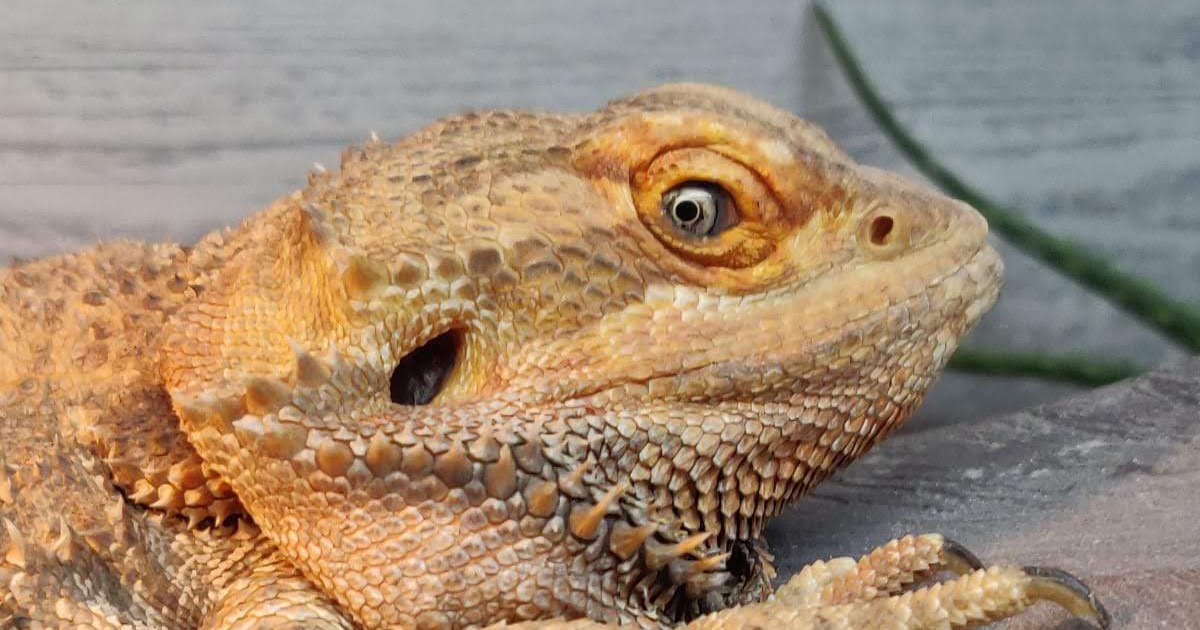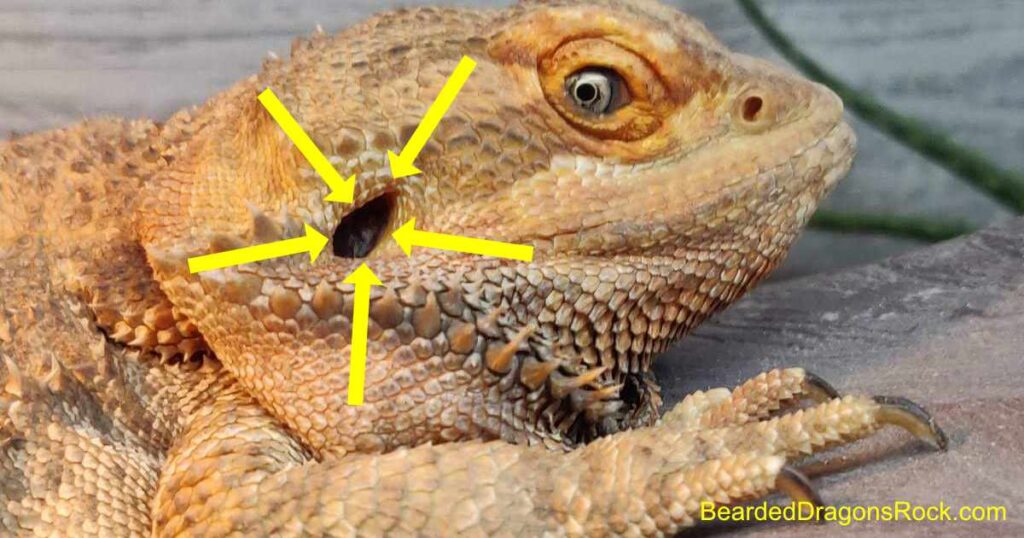Do Bearded Dragons Have Ears?
Do bearded dragons have ears? Where are bearded dragon ears? Bearded dragons do have ears and in this article we show you where they are.

Last Updated: November 22nd, 2021
By: Steve
Table of Contents
We often see people ask ‘Do Bearded Dragons Have Ears?’ along with ‘Where are bearded dragon ears?’ so we’re going to answer that question in this article and elaborate a little on it for you. So read on.
Where Are Bearded Dragon Ears?
The simple answer is yes, bearded dragons do have ears. You can see them as large dark areas on the sides of their head. They don’t have ears in the same sense as humans though, in that there is no cartilage to help direct the sound into the ear canal.
Below is a picture with the bearded dragon ear highlighted with arrows;

Bearded dragon ears are not particularly delicate in every day situations that they would experience. However, there’s a few things to bear in mind in captivity that we may do differently to how bearded dragons would behave in the wild.
Be careful when bathing your bearded dragon not to get the ears too wet. Sometimes your bearded dragon may put their own head under water, and that’s perfectly fine. But if you’re actively pouring water onto them to wash them or because they enjoy it, make sure you avoid pouring water on their head. Bearded dragon ears and eyes aren’t set up to have water, especially chlorinated tap water, poured into them.
Sand, dust, other foreign entities can get into bearded dragon ears if care isn’t taken. Examine your bearded dragon’s ears regularly to make sure there’s no damage to the membrane. It’s relatively unlikely, but it’s worth keeping a check on anyway. Seek veterinary advice if you discover anything foreign in your bearded dragons ear.
You should never, ever push anything into your bearded dragons ears. Cotton buds are a huge no-no and should never be used. The tympanic membrane is delicate and easily ruptured. The same is true of human ears actually – but our tympanic membrane is hidden well inside our ear canal. Bearded dragon ears are more of an ear lake than a canal and it could be tempting to think you might need to clean them. Don’t.
Can I Pull Shed From A Bearded Dragons Ear?
Never ever ever pull shed from around a bearded dragon ear. You will most likely end up pulling the tympanic membrane away and will do significant damage and inflict significant pain.
You should never ever pull shed from any part of a bearded dragon, but the areas around the ears, eyes and nose are especially important. The shed will come away on its own. It’s almost unheard of for a bearded dragon shed to remain stuck in these areas. The bearded dragon has feet (arms) with which it can scratch itself and remove its own shed at its own pace and in its own good time. It does not need any help from you to lift shed from its head. Ever.
If you pull shed from around the ears, eyes, nose or mouth, you risk pulling away the much more delicate membranes in those areas. Those membranes have various different functions and in the case of the tympanic membrane it is a stretched surface of skin which vibrates when sounds are received. This in turn vibrates tiny bones inside the bearded dragon’s head which lead to nerve cells which detect this vibration.
If you tear, remove or otherwise damage this delicate tympanic membrane it will not function properly and your bearded dragon will lose hearing in that ear. This may damage may well be permanent.
The tympanic membrane also has a secondary function, which is to protect the inner ear from dirt, parasites, bacteria, fungi and any other foreign bodies that may wish to invade. It should go without saying that the ears are in close proximity to some very vital organs (ie, brain) that would do well not to be exposed to such pathogens. A damaged bearded dragon ear membrane will likely end up infected and require veterinary treatment.
In short, do not pull shed away from any part of your bearded dragon. You can see our article Bearded Dragon Shedding for further information about where and how to help your bearded dragon shed.
Are Bearded Dragons Deaf?
Following on from whether bearded dragons have ears or not, is the obvious question of whether bearded dragons are deaf or not. Some may be. But most bearded dragons appear to have rather good hearing. Indeed, ours seem to be able to hear locusts walking around before they actually see them – using the ability to determine which direction the locust is in to turn their heads and then see.
Some bearded dragons will even wake up when they hear you enter the room, or if you talk to them.
So no, in general, bearded dragons are not deaf and actually do seem to have quite good hearing.
It should also be considered that bearded dragons probably won’t appreciate loud noises in our around their vivarium, so if you ever want to vacuum your dragons tank you should of course remove the dragon first.
Summary
In this article we’ve learned where bearded dragon ears are, and how to avoid damaging and hurting your bearded dragons ears. We’ve realised we shouldn’t put anything in them, or pull anything out of them (or near to them) without the expert supervision of a bearded dragon vet.
We’ve also learned that bearded dragons can hear quite well and loud noises should be avoided to help reduce the risk of them ending up deaf and to help maintain their everyday comfort.
If there’s anything else you’d like to know about bearded dragons ears please drop us a comment below, or join our Facebook Group and we’ll do whatever we can to help.
Thanks for reading!
